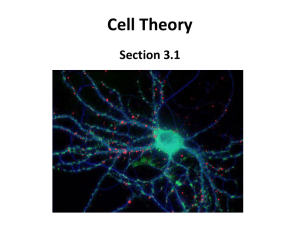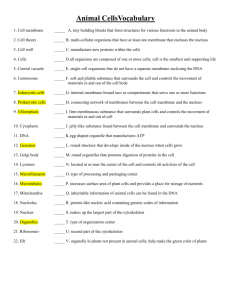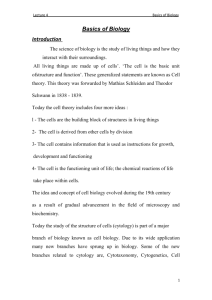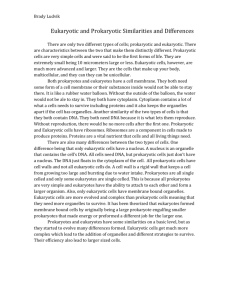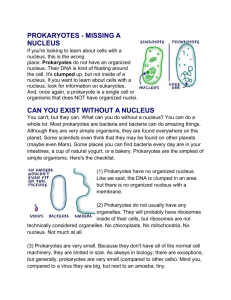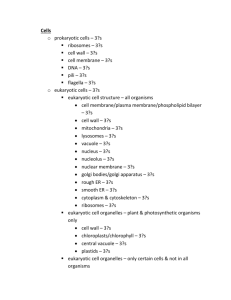pubdoc_12_11162_1727
advertisement
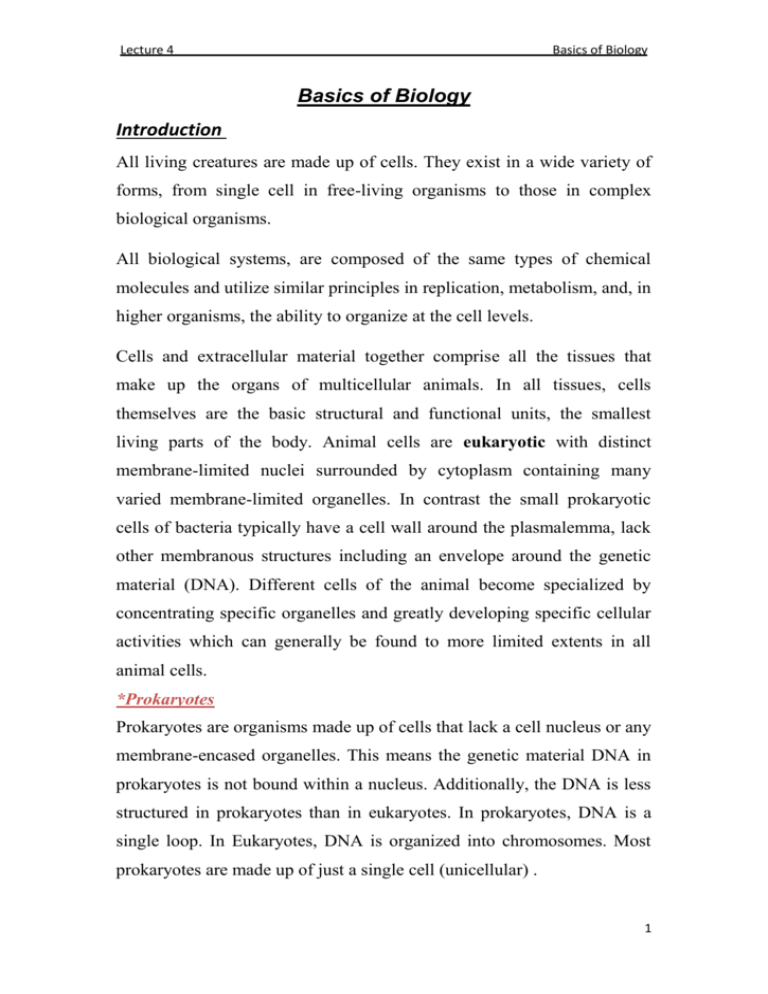
Lecture 4 Basics of Biology Basics of Biology Introduction All living creatures are made up of cells. They exist in a wide variety of forms, from single cell in free-living organisms to those in complex biological organisms. All biological systems, are composed of the same types of chemical molecules and utilize similar principles in replication, metabolism, and, in higher organisms, the ability to organize at the cell levels. Cells and extracellular material together comprise all the tissues that make up the organs of multicellular animals. In all tissues, cells themselves are the basic structural and functional units, the smallest living parts of the body. Animal cells are eukaryotic with distinct membrane-limited nuclei surrounded by cytoplasm containing many varied membrane-limited organelles. In contrast the small prokaryotic cells of bacteria typically have a cell wall around the plasmalemma, lack other membranous structures including an envelope around the genetic material (DNA). Different cells of the animal become specialized by concentrating specific organelles and greatly developing specific cellular activities which can generally be found to more limited extents in all animal cells. *Prokaryotes Prokaryotes are organisms made up of cells that lack a cell nucleus or any membrane-encased organelles. This means the genetic material DNA in prokaryotes is not bound within a nucleus. Additionally, the DNA is less structured in prokaryotes than in eukaryotes. In prokaryotes, DNA is a single loop. In Eukaryotes, DNA is organized into chromosomes. Most prokaryotes are made up of just a single cell (unicellular) . 1 Lecture 4 Basics of Biology *Eukaryotes Eukaryotes are organisms made up of cells that possess a membranebound nucleus (that holds genetic material) as well as membrane-bound organelles. Genetic material in eukaryotes is contained within a nucleus within the cell and DNA is organized into chromosomes. Eukaryotic organisms may be multicellular or single-celled organisms. All animals are eukaryotes. An important feature of the eukaryotic cell is its ability to differentiate and produce a variety of cells, each carrying out a specialized function. Thus, living organisms formed from cells are highly complex and organized and perform a variety of functions : Function Specialized Cell(s) Movement Muscle and other contractile cells Form adhesive and tight junctions between cells Epithelial cells Synthesize and secrete components of Fibroblasts, cells of bone and the extracellular matrix cartilage Convert physical and chemical stimuli into action potentials Neurons and sensory cells Synthesis and secretion of enzymes Cells of digestive glands Synthesis and secretion of mucous substances Mucous-gland cells Synthesis and secretion of steroids Some adrenal gland, testis, and ovary cells Ion transport Cells of the kidney and salivary gland ducts Intracellular digestion Macrophages and some white blood cells Lipid storage Fat cells Metabolite absorption Cells lining the intestine 2 Lecture 4 Basics of Biology Cellular Structure Biological systems are essentially an assembly of molecules where water, amino acids, carbohydrates (sugar), fatty acids, and ions account for 75– 80%of the matter in cells. The remainder of the cell mass is accounted for by macromolecules, also called polymers (or biopolymers in the present case), which include peptides/proteins (formed from amino acids), polysaccharides (formed from sugars), DNA (dioxyribonucleic acid, formed from nucleotide bases and dioxyribose sugar), RNA (ribonucleic acid, formed from nucleotide bases and ribose sugar), and phospholipids (formed from fatty acids). These macromolecular polymers organize to form cells. To contain these molecules, a semipermeable membrane (phospholipid bilayer) surrounds them to form a cell. Within this biological universe, two types of organized cells exist these are as referred above is: 1- Prokaryotic cells (bacteria) are cells with little internal structure and no defined nucleus. 2- Eukaryotic cells have a significantly more complex internal architecture including a defined, membrane-bound nucleus. The smallest organized particle is a virus. The smallest self-replicating cells are bacteria. Eukaryotic cells, for the most part, organize to form complex living organisms. From a single pluripotent cell (a cell with the capacity to differentiate into several cell types) arises tissues and organs, and finally a complex living organism. The structure of a cell—specifically, eukaryotic cells—can be described in terms of the various subcellular compartments and the constituent 3 Lecture 4 Basics of Biology chemical species they contain. The main structural components of a cell are: • Plasma membrane, which defines the outer boundary of a cell. This is present in all cells. • Cell wall, which exists in the prokaryotic cells as well as in the eukaryotic cells of plants but not animals. • Cytoplasm, which represents everything within a cell, except the nucleus. • Cytosol, which is the fluid of the cytoplasm. • Organelle, which is the name used for a subcellular compartment in a cell where a specific cellular function takes place. • Nucleus, which contains the chromosomes (genetic information). Organelles are like little organs of a cell that perform various cellular functions, just like organs perform various tasks in a living system. structures: endoplasmic Organelles specifically, are nucleus, reticulum, intracellular mitochondria, cytoskeleton, (or Golgi subcellular) apparatus, lysosomes, and peroxisomes. The following describes some structural aspects of various cellular components and functions they perform. Plasma Membrane: This forms a semipermeable outer boundary of both prokaryotic and eukaryotic cells. This outer membrane, about 4–5 nm thick, is a continuous sheet of a double layer (bilayer) of long-chain molecules called phospholipids. A phospholipid molecule has a long tail of alkyl chain, which is hydrophobic (refuse water), and a hydrophilic head (likes 4 Lecture 4 Basics of Biology water) which carries a charge (and is thus ionic). Phospholipid molecules spontaneously orient (or self-organize) to form a bilayer in which the hydrophobic tails are pointed inwards (shying away from the outer aqueous environment). The hydrophilic, ionic head groups are in the exterior and are thus in contact with the surrounding aqueous environment. This structure is shown in detail in Figure 1. The membrane derives its rigidity by inclusion of cholesterol molecules, which are interdispersed in the phospholipid bilayer. The plasma membrane controls the transport of food, water, nutrients, and ions such as Na+, K+, and Ca2+ (through so-called ion channels) to and from the cell as well as signals (cell signaling) necessary for proper cell function. Figure 1.Schematics of the phospholipid membrane bilayer structure. 5
